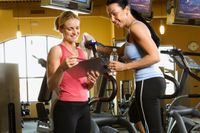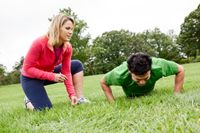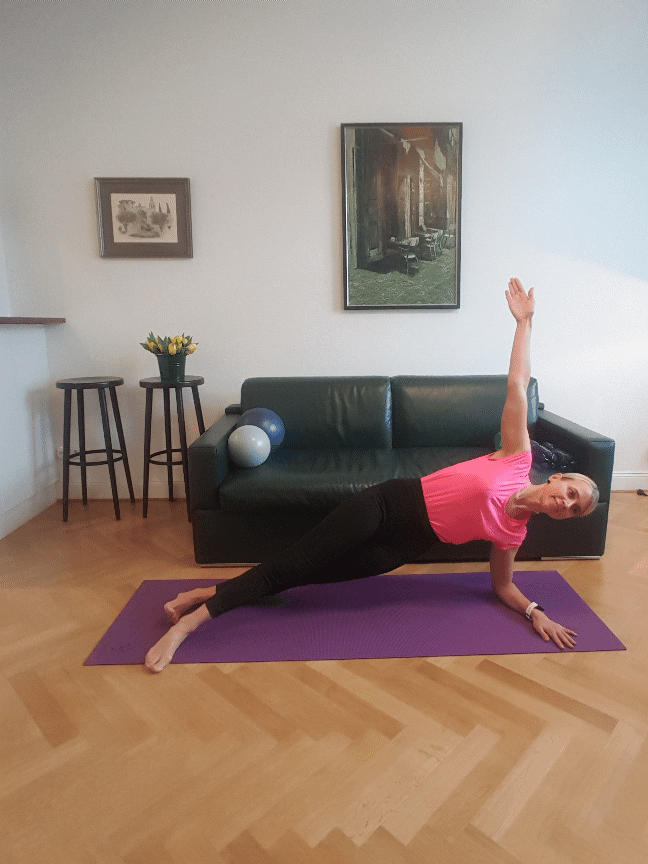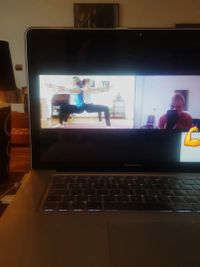FAQs
All your questions about training and nutrition
"I have never trained with a personal trainer before. How does personal training work?"
At the beginning, the target definition and anamnes is take place
What fitness goals do you want to achieve? For example, do you want to lose 10kg, tone your core, effectively reduce your waist size, get rid of back pain, build muscle or become particularly fit for a specific sport, e.g. running or golf?
In order for Juliane to be able to help you achieve your personal goals in the best possible way, she first needs to know and analyse where you currently stand. You will therefore clarify the following questions during an initial appointment or telephone conversation.
- How do you feel, do you have any complaints or pain, do you suffer from chronic illnesses?
- How much exercise do you get in everyday life, what is your posture like, how strong, flexible and enduring is your musculoskeletal system?
- How much energy do you have in everyday life, do you sleep well?
- How high is your workload, do you have a lot of stress, do you have enough time for rest and relaxation?
- What is your weight, height and waist size?
- When do you have time in your day for sport, how much time can you free up for it?
- Do you do other sports, what experience do you have with exercise?
All of this information is incorporated into your personal training plan. Only then can Juliane start planning your first sports sessions. Depending on how quickly you want to achieve your goals and how much time you have available, Juliane will schedule one or more sessions per week. There will be brief feedback after each training session and a regular progress check after a few sessions to make sure you are on the right track. Of
course, Juliane always adapts the training to your daily form. Not everyone can always give 100%. Sometimes we have little time, have hardly slept or are travelling. Then Juliane changes the training so that it is always as effective as possible without overloading you.
"I want to lose weight permanently and as quickly as possible. Is personal training enough or should I also change something in my diet?"
If you want to lose weight effectively and permanently, training should ideally be supplemented with nutritional optimisation. Juliane will analyse your current diet (using a 3-day food log) and give you initial ideas for optimisation. Juliane will then provide you with weekly information, suggestions and specific tips on how to implement them in your everyday life, tailored to your personal situation, dietary preferences, everyday life and family. This is the only way to make the change permanent. You can find more information on nutritional optimisation here.
"How can I get into my personal best shape as quickly as possible (before my next holiday, until my wedding, after pregnancy...)?"
You don't want to lose any time and want results as quickly as possible, because that's the only thing that really motivates you? Then start today with the 3-month programme "Body Transformation".
The entire package includes the following over 12 weeks:
- Personal check-up and anamnesis
- Personal training planning
- 2-3 training sessions per week, depending on the time available, optimal organisation of the sessions (also possible for busy professionals working from home via online training)
- Personal nutritional analysis
- Calculation of basal metabolic rate and personal calorie target (to achieve your individual weight loss target per week, up to 1 kg per week is realistic and possible)
- Nutritional optimisation: weekly tasks for concrete implementation in everyday life, weekly nutritional targets, precisely calculated calorie targets and weekly progress monitoring with feedback
- Personal recipes and tips for long-term implementation in everyday life, also for the family
Enquire now: termin@juliane-fit.de
"How can I imagine online personal training via Zoom?"
A typical online training session begins briefly with an introduction and your feedback on your current form for the day and any wishes or adjustments for the training session. Juliane then explains the structure of the session and the planned exercises. The ideal camera position is also explained and the required materials (chair, mat, etc.) are positioned. Then the training can begin. The first part usually includes a warm-up
with mobilisation and movement of all joints. The shoulders, neck and back are loosened up first and prepared for exercise, especially in the case of back pain.
Juliane shows you each exercise in detail and explains all the important details. She looks closely during training and gives the right instructions during execution so that the participant always maintains the correct posture. From her experience, she knows the "weak points" of each exercise and can achieve optimal execution both by demonstrating
and explaining the details in detail. Juliane is very precise and pays attention to all the small details, because quality plays a key role in the execution and effect of the exercise. This is the only way to ensure that the exercises are 100% effective and safe. The exercise selection is based on your goals as well as your current form on the day. This can vary and
it doesn't make sense to do a tough workout after a sleepless night. Sometimes back problems or other pain also need to be taken into account. Thanks to her many years of experience, Juliane can respond spontaneously and individually to all needs and adapt each exercise so that the body is always optimally stressed. In this way, personal goals can be achieved safely.
In the cool-down or final part (depending on the training goal), for example, relaxation is the order of the day and the class concludes with suitable exercises for stretching, relief and relaxation. Juliane always works with position and counter-position, i.e. all muscles are always stretched evenly and no areas of the body are neglected. A final feedback rounds off the lesson, Juliane assigns and explains the respective homework until the next lesson and notes the progress of the exercises.
"Why should I keep a food log and what is the best way to do this?"
When starting to optimise your diet, it makes sense to keep a log of your current diet for a few days. write down what you eat, simply because it will give you a lot of input about your eating behaviour. Of course, it is a bit time-consuming to weigh and write down everything for a few days, but you can easily enter it into a calorie counting app, for example, if you want to. The advantage is that you immediately receive a comprehensive analysis of calories and nutritional values. We all have a blind spot when it comes to nutrition! Many people think, for example, that they eat too many carbohydrates, but the analysis sometimes reveals a much
too high fat or protein content. Such a realisation can work wonders. You can download a template for creating a nutrition log here.
The details make all the difference!
It is important to write down everything exactly during the three days, as this is the only way to obtain a complete analysis. So not "bread with cheese" but very precisely, preferably with the quantity or number of grams, fat level etc.: 1 slice of bread á 65g with 1 slice of Gouda
cheese (25g) á 45% fat. This can be a bit tedious at first, but the app already provides this information. You can also scan the food using a barcode, which is even quicker.
Be honest with yourself and gain useful insights from the analysis
Above all, be honest with yourself and really write everything down. If you like, you can also send Juliane your notes by email (termin@juliane-fit.de) and she will analyse and evaluate them for you.
FAQs after pregnancy
You've just become a mum and want to improve your fitness, but you also have questions about topics such as losing weight, bladder weakness, rectus diastasis and Pelvic floor problems? Here are some answers to the most frequently asked questions about pelvic floor fitness.
Am I really tensing the pelvic floor or rather the bum muscle?
This is the reason why most people tend to tighten their stomach, legs and buttocks when they want to reach the pelvic floor. We know them well and the connections to the brain are strong. In addition, the pelvic floor is a rather delicate muscle compared to the buttocks. If you really want to practise effectively, you should first learn to perceive the pelvic floor muscles in isolation in order to understand how it feels to stabilise yourself from the inside out. Then, in a second step, you can combine this strength of the centre with the outer muscles, which leads to light, dance-like yet well-grounded movements and a narrow and tight centre. Exactly what we want for any sport!
This is why there are many attempts in Pilates, yoga and sport in general to address the core of the body and therefore also the pelvic floor - based on the subconscious knowledge that it makes movements better: "pull the belly button inwards", or "pull the pelvic floor inwards". "Tighten your bum" is one such phrase. You can be sure that whether it's yoga or pumping, equipment or Nordic walking - anyone who knows and can use their pelvic floor has a clear advantage in any sport. What's more, "tighten your pelvic floor" is a grossly simplistic instruction, and unfortunately the wrong layer is usually tightened far too much.
Tips for getting to know how the pelvic floor works on your own body
does more harm than good.
I am very sporty, do I need to train the pelvic floor separately or is it automatically fit?
Female athletes usually have a tense, overtrained middle pelvic floor layer. The pelvic floor muscles function well when they are fit, elastic, strong and responsive, but not when they are tense, overtrained or flaccid. The middle layer is also too strong, especially in sportswomen. The pelvic floor cannot fulfil its function and incontinence and pelvic floor problems can occur in the same way as with an untrained pelvic floor. Active sportswomen
usually have a tense, overtrained middle layer of the pelvic floor. This is relieved by training the inner, correct layer (levator ani).
Is there such a thing as incorrect pelvic floor training?
Incorrectly understood or incorrectly implemented training of the pelvic floor muscles can force the pelvis and pelvic bones into positions that have an unfavourable effect on the leg and pelvic joints and subsequently cause poor posture. Osteoarthritis can occur if joint parts do not have the necessary distance between them and rub against each other. Excessive contraction and activation of the middle layer of the pelvic floor is often reflexively combined with additional tensing of the gluteal muscles. The hip joints become too tight and the thighs are forced into a knock-kneed
position, which permanently damages the feet and knee joints. Many women have problems jogging after pregnancy - for precisely these reasons. Complaints in the lumbar vertebrae and pelvis can be caused or exacerbated - as these are almost always triggered by a sub-optimal posture and a pelvic position that is not in line with the body's structure.
Where is the actual pelvic floor?
The pelvic floor consists of three layers: The outer layer (these are the sphincter muscles), the middle layer (runs transversely) and the very innermost layer (the actual pelvic floor, called the levator ani, runs long and fan-shaped). The middle layer connects the ischial tuberosities and the branches of the pubic bone transversely and closes the front area of the pelvis. In women, this layer is only half as strong as in men. The muscle movement of
the middle layer is very delicate even when correctly activated and for this reason most women usually tense far too much on suspicion. Less is more here, even if it is difficult to let go!
The innermost layer tends to lash the pelvis longitudinally again, in a fan shape, to ensure the greatest possible stability and support. Contrary to what the term "pelvic floor" suggests, this innermost layer does not form a flat plate, but rather a bowl with quite steep edges and supports our pelvic organs. The easiest way to activate it is by straightening the pelvis - or simply imagining this movement - and gently pulling the ischialtuberosities together and upwards. Even if it may seem so from the illustrations, the pelvic floor is not an isolated muscle group in the body, as the innermost layer in particular is intensively networked with the legs, back and abdomen via various fasciae and is therefore very important for our posture and coordinated movement.
The anatomy of the abdomen, the waist shaper, the perfect pelvic position
Always hold the basic position in which the abdominal wall is flat, long and comfortably stretched and the waist is visibly exposed. As soon as the abdominal muscles bulge or clench as a result of exertion, stop exercising and rebuild the position.
In the perfect pelvic position, the deep muscles of the pelvis, back, hips and abdomen combine to form a natural corset that keeps the waist nice and narrow. This perfect pelvic floor training keeps the pelvis in ideal shape, straightens the spine and makes it flexible, relieves pressure in the legs and feet as well as the shoulders and head. It protects, supports and actively massages the organs. Everything comes together in the levator ani.
The hip flexors and the deep back muscles connect with the large, oblique and transverse abdominal muscles. Conventional training of the transverse abdominal muscles swallows the waist and makes the figure boxy.
Training the transversus (waist shaper) correctly is particularly important: if it is trained transversely (as is unfortunately usually shown in conventional gym classes), it tilts the pelvis unphysiologically, swallows the waist and makes the figure boxy and "masculine". When stretched and properly networked, on the other hand, it forms a perfect team with the transverse abdominal muscles, the hip flexor and the pyramid muscle that harmonises the Connects the torso criss-cross. Above this lies the long straight abdominal muscle, which gives the stomach a nice flat shape.






